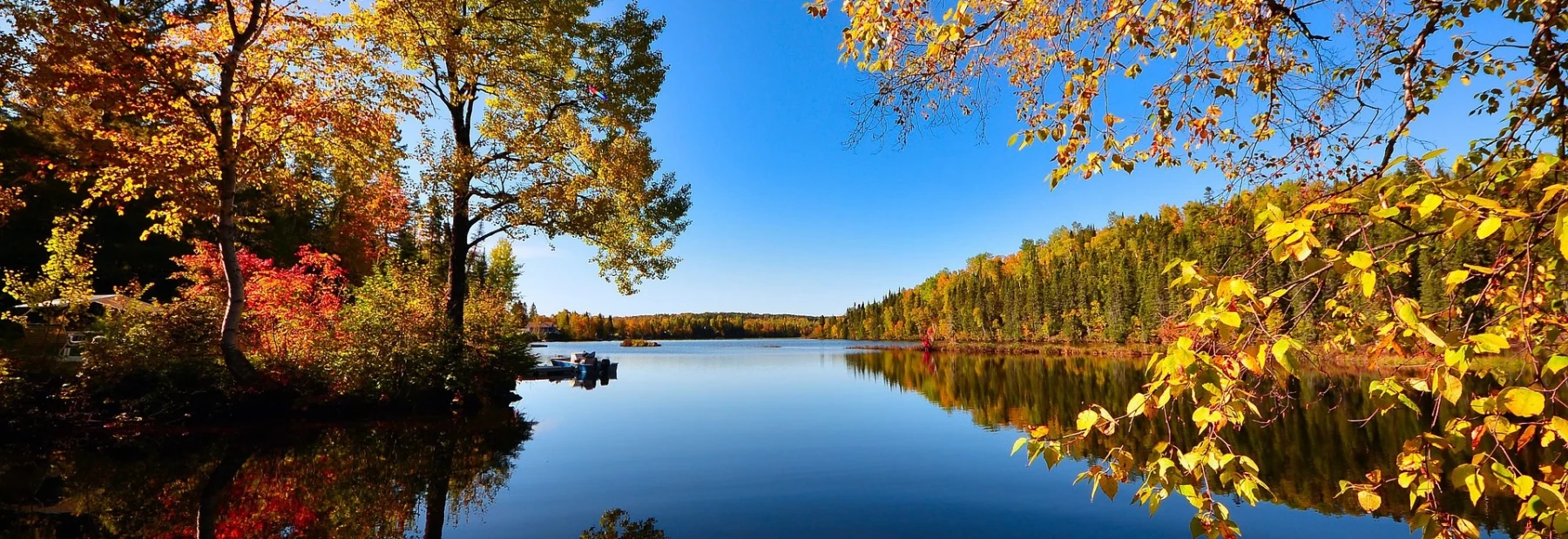To visit - Quebec
Quebec, a captivating gem in the Canadian landscape, invites travelers to a journey through history and culture. With its UNESCO-listed Old Quebec, adorned with cobblestone streets and imposing fortifications, the city exudes the enchanting charm of medieval Europe.
The iconic Château Frontenac, a regal silhouette on the skyline, stands as a symbol of historical richness and grandeur. Explore the historic Citadelle, a 17th-century military fortress, unveiling Canada's military heritage through engaging guided tours.
A leisurely stroll along the Samuel-De Champlain Promenade unveils breathtaking views of the mighty St. Lawrence River, offering a romantic setting, especially during the golden hues of sunset. Seeking tranquility within the city, Parc de l'Artillerie provides a serene escape with shaded trails and panoramic views of Old Quebec.
The Petit Champlain district, one of North America's oldest shopping quarters, captivates with its charming boutiques, art galleries, and inviting cafes. The Festival d'Été de Québec transforms the city into a lively celebration of music, street arts, and open-air performances, creating an electrifying atmosphere.
The historic Place Royale, with its vibrant facades and lively squares, echoes the French roots of North America. Quebec's museums, such as the Musée de l'Amérique francophone and the Musée national des beaux-arts du Québec, showcase rich collections brimming with history, art, and culture.
Embark on a culinary journey through Quebec's gastronomy, where iconic delights like poutine and innovative creations from local chefs tantalize the taste buds. Quebec is a captivating blend of historical heritage, European ambiance, and natural splendor, offering an enchanting travel experience.
The 9 essential things to do in Quebec :
Summary
1 - Old Quebec
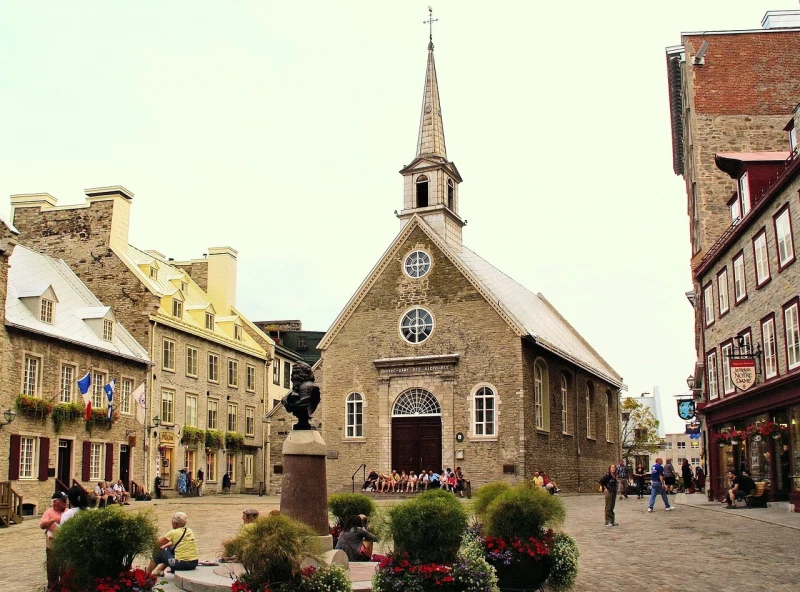
The Old Quebec, a historic gem nestled in the heart of the eponymous city, offers an enchanting journey through time.
Its cobblestone streets, lined with buildings featuring colorful facades, transport visitors to a realm where the history of New France unfolds at every turn. The imposing ramparts bear witness to a fortified past, while the majestically towering Château Frontenac dominates the landscape.
Quaint cafes and artisanal boutiques in the Petit-Champlain District invite a leisurely stroll, while the Place Royale, adorned with welcoming squares, reveals the lively spirit of this exceptional place.
The Dufferin Boardwalk provides a panoramic view of the majestic Saint Lawrence River, adding a poetic dimension to this escapade. At each step, the Saint-Jean and Saint-Louis gates open temporal passages, reminiscent of an era when Quebec was a fortified city.
Come evening, the warm lighting accentuates the architectural beauty of this charming quarter, inviting travelers to savor the authenticity of a place where each stone tells a story.
 Our tips for getting the most out of your experience.
Our tips for getting the most out of your experience.
Visiting Old Quebec can be a rewarding experience. Here are some tips to make the most of your stay:
-
Explore on Foot: Old Quebec is a neighborhood where every corner has something to offer. Take the time to stroll around on foot to discover narrow alleys, hidden squares, and architectural details.
-
Visit Early in the Morning or Evening: Old Quebec is less crowded early in the morning or in the evening, allowing you to enjoy a quieter atmosphere and take stunning photos without the crowds.
-
Take the Funicular: For a unique experience, take the funicular that connects Upper Town to Lower Town. You'll have a magnificent view of the Saint Lawrence River during the ride.
-
Take Advantage of Guided Tours: Guided tours can provide in-depth historical and cultural information. Whether on foot, by carriage, or by boat, these tours can give you a fascinating insight into the region's history.
-
Try Local Specialties: Old Quebec is home to many restaurants offering traditional Quebecois dishes. Try poutine, tourtière, or other local delights.
-
Visit Museums: Old Quebec houses several museums, such as the Museum of French America. These institutions can deepen your understanding of the region's history and culture.
-
Attend Local Events: Check the calendar for local events. Old Quebec often hosts festivals, concerts, and other activities that can enhance your experience.
-
Go to the Observatoire de la Capitale: For a panoramic view of Quebec, visit the Observatoire de la Capitale located at the top of the Marie-Guyart building.
-
Allocate Time for Shopping: The shops in the Petit-Champlain district offer unique items. Take the time to shop and discover local souvenirs.
-
Use Public Transportation: Quebec City has a well-developed public transportation network. Use it to move easily between different parts of Old Quebec.
By following these tips, you can fully immerse yourself in the charm and history of Old Quebec. Enjoy your trip!
2 - The Citadel of Quebec
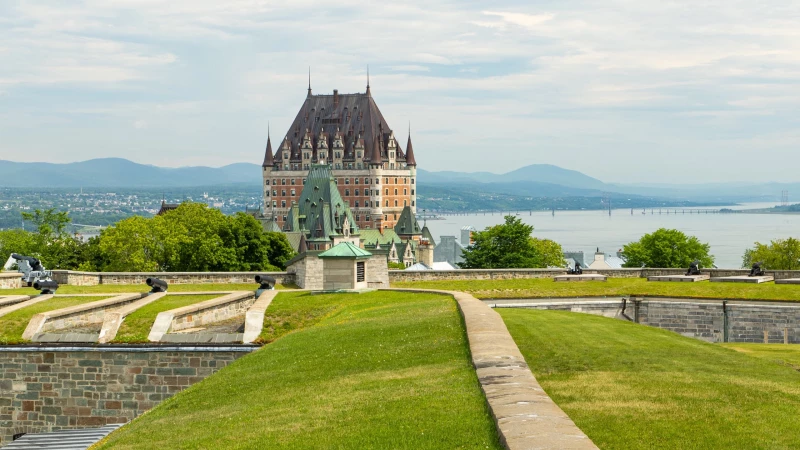
Perched atop the heights of Upper Town, the Citadelle de Québec invites travelers on a captivating journey through the ages. Crowned against the urban skyline, this military fortress imposes its commanding silhouette, a living testament to Canada's military history. Its ramparts, bastions, and cannons delve into the past, evoking periods of conflict that have shaped the region. Knowledgeable guides share poignant narratives, unveiling the intrigues and strategies that have marked the Citadelle over the years.
From the heights of the fortifications, the breathtaking panoramic view of the Saint Lawrence River and Old Quebec offers a unique perspective of the city and its surroundings. The traditional accents of the changing of the guard exercises add a touch of spectacle to this immersive experience.
Well-maintained gardens and green spaces create a peaceful atmosphere, contrasting with the martial character of the Citadelle. The elegant architecture of the barracks and the military museum enrich the visit by revealing more fascinating aspects of this historic emblem.
Whether exploring its underground passages or strolling on the esplanade, the Citadelle de Québec invites travelers to immerse themselves in a rich past and savor the military grandeur of this iconic fortress.
 Our tips for getting the most out of your experience.
Our tips for getting the most out of your experience.
Visiting the Citadelle de Québec is a captivating historical experience. Here are some tips to enhance your visit:
-
Opt for a Guided Tour: Knowledgeable guides can provide in-depth insights into the military history of the Citadelle. Learn more about its fortifications, secrets, and anecdotes.
-
Attend the Changing of the Guard: The Changing of the Guard ceremonies are iconic. Check the schedule to plan your visit accordingly and witness this spectacular military tradition.
-
Explore the Underground Passages: The Citadelle has a fascinating network of underground passages. Take the time to explore these tunnels to discover lesser-known aspects of the fortress.
-
Walk the Ramparts: Enjoy panoramic views of Quebec by walking along the Citadelle's ramparts. It's an excellent way to capture stunning photos of the city and the Saint Lawrence River.
-
Visit the Royal 22e Régiment Museum: This military museum within the Citadelle showcases exhibits on the history of the regiment and military life over the years.
-
Check Opening Hours: Make sure to check the opening hours before planning your visit. Some areas may have specific hours for guided tours or special events.
-
Prepare for Weather Conditions: Much of the Citadelle is outdoors, so dress according to the weather, especially if you plan to visit the ramparts or outdoor spaces.
-
Purchase Tickets in Advance: If possible, buy your tickets online in advance to avoid queues, especially during peak times.
-
Enjoy the Gardens: The Citadelle gardens offer a peaceful setting. Take the time to relax in these well-maintained green spaces.
-
Ask Questions to Guides: Feel free to ask questions to the guides during the tour. They can provide additional information and interesting anecdotes.
By following these tips, you'll be able to fully appreciate the military history and unique atmosphere of the Citadelle de Québec.
3 - Notre-Dame-de-Québec Cathedral
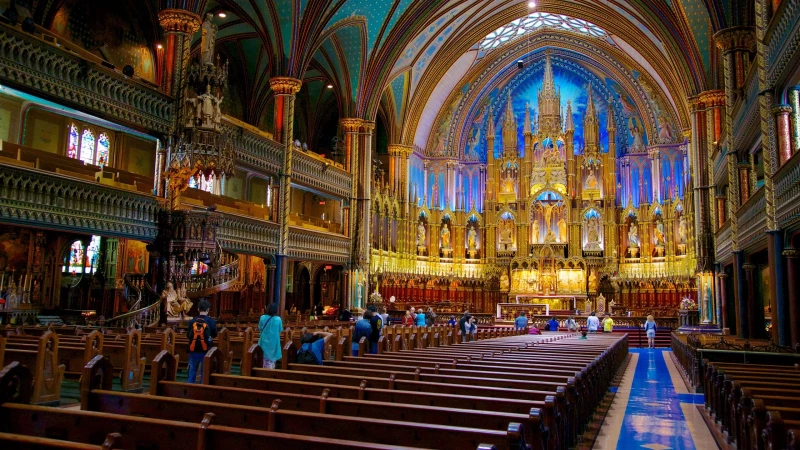
The Notre-Dame-de-Québec Cathedral, located at the heart of Upper Town, is an architectural gem reflecting the religious history of the region since the 17th century. Its foundations trace back to the first church built in 1647 by the early French settlers. The present structure, completed in 1843, stands as a striking example of neo-Gothic architecture.
The beautiful stained glass windows and religious artworks inside bear witness to the cathedral's spiritual significance. It has been witness to numerous historical events, including the funerals of General Montcalm and Admiral Nelson.
The sacred site attracts not only the faithful but also history and architecture enthusiasts. Its majesty, serenity, and role in religious heritage make it a must-visit for those exploring Québec. The cathedral's towers offer a breathtaking view of the city, completing a rich and contemplative visit.
 Our tips for getting the most out of your experience.
Our tips for getting the most out of your experience.
Exploring the Notre-Dame-de-Québec Cathedral can be a rewarding experience. Here are some tips to make the most of your visit:
-
Attend a Mass or Religious Service: If it aligns with your preferences, attending a Mass or religious service can allow you to experience the cathedral's spiritual atmosphere.
-
Take Advantage of Guided Tours: Guided tours often provide detailed information about the history, architecture, and artwork of the cathedral. It's an excellent way to deepen your understanding of the site.
-
Admire the Stained Glass Windows: Take the time to admire the beautiful stained glass windows that adorn the cathedral. Each tells a biblical or historical story, adding an artistic touch to your visit.
-
Explore the Side Chapels: The side chapels of the cathedral often house specific altars and artworks. Explore them to discover less obvious details.
-
Participate in Special Events: Check the cathedral's calendar to see if there are concerts, exhibitions, or other special events happening during your visit.
-
Check Opening Hours: Make sure you know the opening hours, as they may vary depending on the day of the week and special events.
-
Respect the Tranquility: As it is a place of worship, try to maintain respectful behavior and speak in low tones to not disturb the tranquility of the place.
-
Check the Website: Before visiting, check the cathedral's website for the latest information on opening hours, entrance fees, and upcoming events.
-
Photograph Thoughtfully: If photography is allowed, be respectful to the worshippers and avoid using flash, especially during ceremonies.
-
Take Time for Contemplation: The Notre-Dame-de-Québec Cathedral is a place rich in history and spirituality. Take the time to sit, meditate, and appreciate the unique atmosphere of the place.
By following these tips, your visit to the Notre-Dame-de-Québec Cathedral will be a memorable experience, blending history, art, and spirituality.
4 - The Samuel-De Champlain Promenade
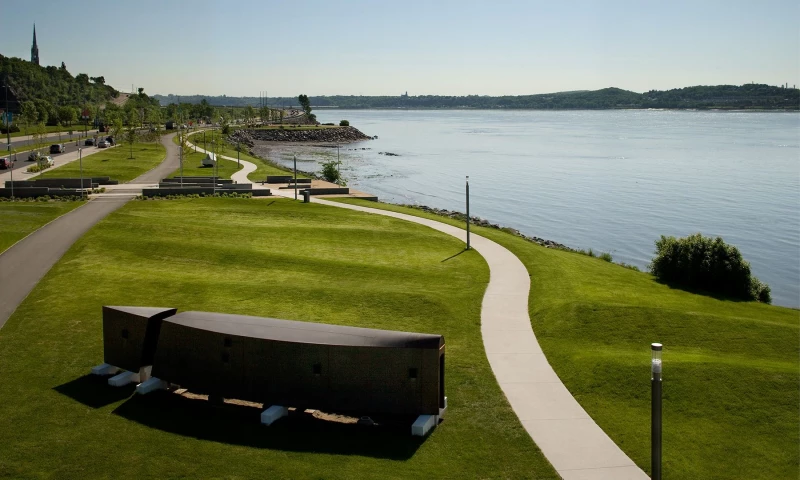
The Samuel-De Champlain Promenade, stretching along the St. Lawrence River in Quebec, provides a picturesque experience blending nature and urbanity. Lined with carefully landscaped green spaces, this promenade offers spectacular views of the river and the bridges spanning it. Pedestrian and cycling paths invite leisurely strolls or bike rides, creating an atmosphere conducive to relaxation and contemplation.
Strategically placed resting areas allow visitors to enjoy exceptional panoramas, while artistic installations scattered along the promenade add a cultural touch to the experience. The Samuel-De Champlain Promenade is also a popular venue for various outdoor events, from festivals to artistic performances.
Whether for a leisurely family stroll, a morning jog, or simply to savor the natural beauty of the St. Lawrence, this promenade provides a tranquil respite in the heart of the city.
 Our tips for getting the most out of your experience.
Our tips for getting the most out of your experience.
Exploring the Samuel-De Champlain Promenade is a delightful experience. Here are some tips to make the most of your visit:
-
Wear Comfortable Shoes: The promenade features pedestrian and cycling paths, so be sure to wear comfortable shoes to fully enjoy the stroll.
-
Bring a Picnic: The resting areas along the promenade provide an ideal setting for a picnic. Bring a snack or a meal and enjoy the view of the river.
-
Explore Art Installations: Artistic installations dot the promenade. Take the time to explore these artworks to add a cultural dimension to your experience.
-
Check for Local Events: The promenade regularly hosts outdoor events. Check the local calendar to see if there are festivals, concerts, or other activities during your visit.
-
Opt for a Bike Ride: If you have a bike, the promenade is perfect for a cycling adventure. You can also rent a bike on-site for a different experience.
-
Visit at Sunrise or Sunset: Sunrise or sunset moments offer beautiful light on the river. It's an ideal time for a romantic stroll or to capture stunning photos.
-
Take Your Time: The Samuel-De Champlain Promenade is designed to be enjoyed at a relaxed pace. Take your time to savor the landscapes, rest on benches, and soak in the serene atmosphere.
-
Check Viewing Points: Identify viewing points along the promenade for panoramic views. Some spots offer unique perspectives of the city and the river.
-
Stay Informed about Weather Conditions: Depending on the weather, make sure to be prepared. Whether with sunscreen in summer or a warm jacket in winter, adjust your attire accordingly.
-
Respect the Environment: To preserve the natural beauty of the promenade, make sure to respect the environment by leaving no litter behind.
By following these tips, you can fully enjoy the Samuel-De Champlain Promenade and its unique ambiance along the St. Lawrence River.
5 - The Museum of French-speaking America
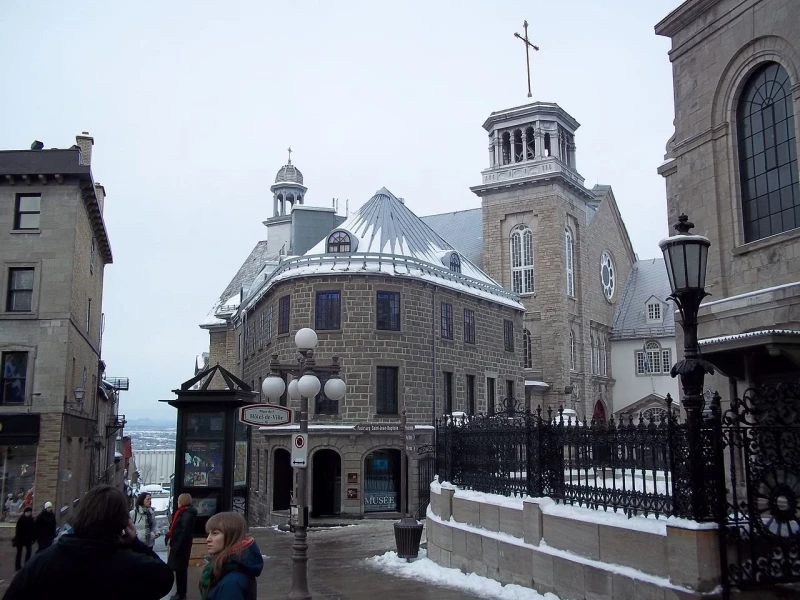
The Musée de l'Amérique francophone, located in the heart of Old Quebec, is a cultural treasure that traces the fascinating history of the French-speaking presence in the Americas. Founded in 1806, it stands as the oldest museum in Quebec. The rich and diverse collections span the realms of art, history, and culture, providing a captivating immersion into the past of New France and beyond.
Both temporary and permanent exhibitions highlight unique aspects of Francophone history, from early explorations to contemporary cultural developments. The museum also houses a specialized library, further deepening visitors' understanding.
The museum's magnificent architecture, seamlessly integrated into the historic district, provides an ideal backdrop for this cultural exploration. Whether for history enthusiasts, art lovers, or the simply curious, the Musée de l'Amérique francophone offers a enriching experience in the heart of Quebec City.
 Our tips for getting the most out of your experience.
Our tips for getting the most out of your experience.
Visiting the Musée de l'Amérique francophone can be a rewarding experience. Here are some tips to make the most of your visit:
-
Plan Your Visit: Check the museum's website for information on temporary exhibitions, opening hours, and special events. Plan your visit accordingly.
-
Explore Permanent Exhibitions: Start with the permanent exhibitions that provide an in-depth perspective on the Francophone history in America, from New France to the present day.
-
Discover Temporary Exhibitions: Temporary exhibitions showcase specific aspects of Francophone history and culture. Don't miss the opportunity to explore these unique displays.
-
Join a Guided Tour: Guided tours can provide in-depth information and interesting anecdotes. It's an excellent way to gain additional insights into the collections.
-
Take Advantage of Educational Activities: If the museum offers educational activities or workshops, consider participating. It can enhance your experience and make the visit more interactive.
-
Explore the Library: If time allows, visit the museum's specialized library. It is a treasure trove of resources related to Francophone history and culture.
-
Use Audioguides: If available, audioguides can offer detailed commentary on the exhibitions, allowing you to gather additional information while exploring at your own pace.
-
Check for Special Events: Consult the calendar for special events or lectures that may be taking place during your visit. This could add a unique dimension to your experience.
-
Capture Memories: Take photos, but be sure to follow the museum's rules regarding photography. It's an excellent way to remember your visit.
-
Visit the Museum Shop: The museum shop may offer unique souvenirs related to Francophone history. Take some time to browse and find memorable keepsakes.
By following these tips, you can explore the Musée de l'Amérique francophone in a more immersive and enriching way.
6 - Fairmont Frontenac Castle
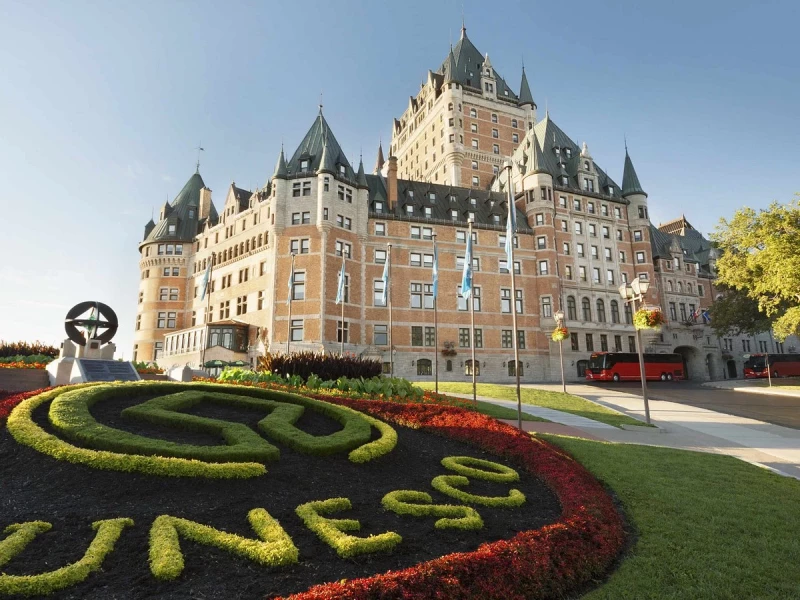
The Fairmont Le Château Frontenac, a majestic landmark overlooking Upper Town in Quebec City, is more than just a luxurious hotel – it is a historic icon. Inaugurated in 1893, it embodies timeless elegance and the architectural heritage of the city. Perched on Cap Diamant, it offers breathtaking views of the Saint Lawrence River and the picturesque surroundings.
Its castle-style architecture, inspired by French medieval castles, captivates visitors. Inside, sumptuous spaces and decorative elements evoke a bygone era. The rooms and suites blend modern luxury with classic charm.
The Château Frontenac has hosted illustrious personalities and witnessed historic moments. It features a range of restaurants, including the renowned Champlain, offering a refined gastronomic experience. Whether staying or just strolling through, the Château Frontenac allows one to appreciate its history and aura of grandeur.
 Our tips for getting the most out of your experience.
Our tips for getting the most out of your experience.
Visiting the Fairmont Le Château Frontenac can be an exceptional experience. Here are some tips to make the most of your visit:
-
Appreciate the Exterior Architecture: Take the time to admire the impressive architecture of Le Château Frontenac from the outside. Its medieval castle style stands out and offers unique photographic opportunities.
-
Explore the Interior: Even if you're not staying at the hotel, you can enter and explore some public areas of Le Château Frontenac. The lobbies and lounges are often beautifully decorated.
-
Relax in Common Areas: The common spaces of the Château, such as the lobby, are often welcoming and elegant. Take the opportunity to relax and soak in the atmosphere.
-
Visit the Shops: Le Château houses several shops, ideal for finding unique souvenirs or gifts. Explore the stores to discover quality items.
-
Dine in One of Its Restaurants: Even if you're not staying, you can enjoy a culinary experience by booking a table in one of Le Château Frontenac's restaurants. The Champlain restaurant offers fine dining.
-
Enjoy Panoramic Views: If you have the chance to go up to the terrace or certain publicly accessible areas, take advantage of the spectacular panoramic views of the city and the St. Lawrence River.
-
Join a Guided Tour: Some guided tours can provide you with an in-depth insight into the history and anecdotes related to Le Château Frontenac. Inquire about available options.
-
Check for Special Events: Consult Le Château's calendar to see if there are special events, concerts, or temporary exhibitions during your visit.
-
Book in Advance: If you plan to dine in one of the restaurants, join a guided tour, or enjoy other services, it may be wise to book in advance, especially during peak times.
-
Appreciate the History: Learn about the history of Le Château Frontenac and its role in Quebec's history. This will add an extra layer to your experience.
By following these tips, you can fully enjoy your visit to Le Château Frontenac and appreciate its historical and architectural grandeur.
7 - The Petit-Champlain district
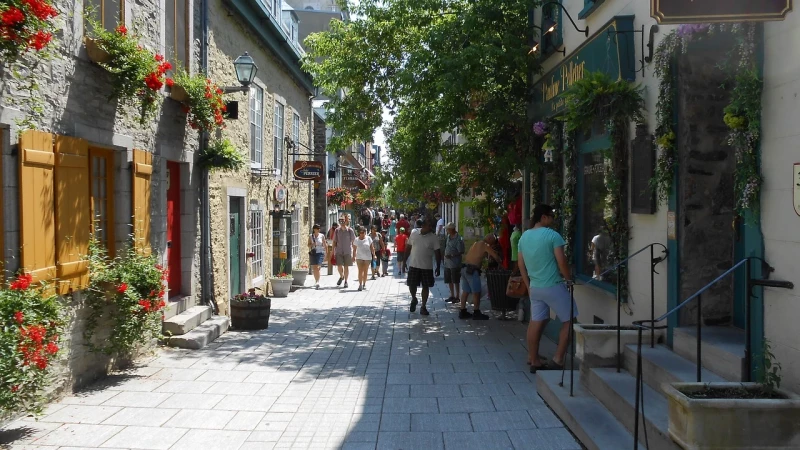
The Petit-Champlain district, nestled in the heart of Old Quebec's Lower Town, is one of the most picturesque and charming neighborhoods in the city. Paved with narrow streets, lined with colorful houses, and dotted with artisan shops, it is a true historical gem.
The facades of the shops and restaurants in the Petit-Champlain district exude an authentic European atmosphere, reminiscent of the New France era. The picturesque architecture adds a romantic touch to the stroll, and the cobblestone alleys invite leisurely exploration.
The shops are filled with unique treasures, ranging from local crafts to elegant jewelry and clothing. Café terraces provide an ideal spot to enjoy a culinary break while observing the lively street scene.
At the end of Rue du Petit-Champlain, you'll discover Place Royale, one of the city's most historic sites. The magnificent Trompe-l'Œil mural on Cul-de-Sac Street adds an artistic dimension to this already enchanting neighborhood.
Whether for shopping, tasting local specialties, or simply taking a romantic stroll, the Petit-Champlain district offers an immersive experience in the historical charm of Quebec City.
 Our tips for getting the most out of your experience.
Our tips for getting the most out of your experience.
Exploring the Petit-Champlain district is an unforgettable experience. Here are some tips to make the most of your visit:
-
Start Early in the Morning or Late in the Day: The district is often quieter early in the morning or late in the day, allowing you to enjoy the peaceful atmosphere more fully.
-
Stroll Through the Alleyways: The cobblestone alleys are full of charm and little surprises. Take the time to venture into these picturesque lanes.
-
Explore Local Shops: The artisanal shops offer unique items. Take the time to discover local creations, from jewelry to art pieces.
-
Taste Local Specialties: Cafés and restaurants in the area often feature local specialties. Sample Quebecois cuisine at one of the charming terraces.
-
Admire the Trompe-l'Œil Mural: Don't miss the Trompe-l'Œil mural on Cul-de-Sac Street. It tells the story of the neighborhood in an artistic and captivating way.
-
Opt for a Guided Tour: Some guided tours provide historical anecdotes and interesting details about the district. It's an excellent way to deepen your understanding.
-
Be Prepared for Stairs: The district is located on hilly terrain. Expect to climb up and down stairs, but rest assured that the views are worth it.
-
Photograph the Colorful Facades: The colorful houses in the district are iconic. Take photos of the picturesque facades to capture the essence of the neighborhood.
-
Check the Event Schedule: See if there are any special events or performances scheduled during your visit. The district sometimes hosts festivals and outdoor shows.
-
Take Time to Sit: Find a bench or terrace, sit down, and soak in the atmosphere. It's a neighborhood where taking your time is truly enjoyable.
By following these tips, you can fully appreciate the magic of the Petit-Champlain district and have an authentic experience in the heart of Quebec's history.
8 - Montmorency Falls
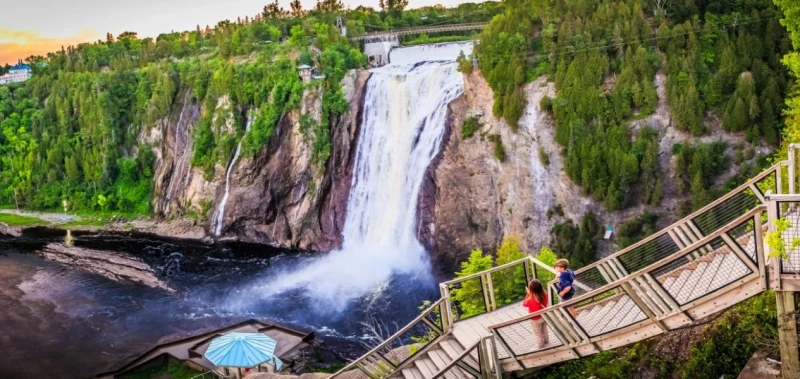
The Montmorency Falls, located just minutes from Quebec City, offer a breathtaking natural spectacle. Standing at a height of 83 meters, they surpass Niagara Falls in terms of sheer height. The site features several observation points, including a suspended footbridge that provides spectacular views of the falls and the lower basin.
The falls are stunning in every season. In winter, the mist creates a backdrop of glistening ice, while in summer, lush vegetation surrounds the cascades. Hiking trails allow visitors to explore the surroundings, offering different perspectives on the falls and the region.
The panoramic elevator and zipline above the falls add an adrenaline rush to the experience. The Montmorency Falls Park also offers picnic areas, restaurants, and shops, providing a full day of natural adventure near the city of Quebec.
 Our tips for getting the most out of your experience.
Our tips for getting the most out of your experience.
Visiting Montmorency Falls is a captivating experience. Here are some tips to make the most of your visit:
-
Check the Weather Conditions: Before your visit, check the weather conditions, especially in winter when trails may be icy. Dress accordingly for the conditions.
-
Explore the Suspended Footbridge: Take advantage of the spectacular view of the falls from the suspended footbridge. It's a safe and thrilling way to appreciate the power of the falls.
-
Hike the Trails: The hiking trails around the falls offer different perspectives. Choose a hike that matches your comfort level to explore the surroundings.
-
Opt for the Panoramic Elevator: If you prefer a high vantage point without walking, use the panoramic elevator to view the falls from the top.
-
Zipline Over the Falls: For thrill-seekers, the zipline provides a unique experience by flying over the falls. Check conditions and restrictions before making a reservation.
-
Visit Manoir Montmorency: The Manoir provides historical information about the area. It's also a great place to rest and enjoy the view.
-
Picnic in the Park: Bring a picnic to enjoy the surrounding nature. The park has picnic areas where you can relax while admiring the falls.
-
Check for Scheduled Events: Some days may feature special events, such as fireworks. Check the event calendar not to miss out.
-
Avoid Crowds: For a more peaceful experience, consider visiting early in the morning or on weekdays when crowds are lighter.
-
Purchase Tickets Online: If possible, buy your tickets online in advance to avoid waiting in lines at the ticket booth.
By following these tips, you can fully enjoy your visit to Montmorency Falls and discover the impressive natural beauty of this site.
9 - Île d'Orléans
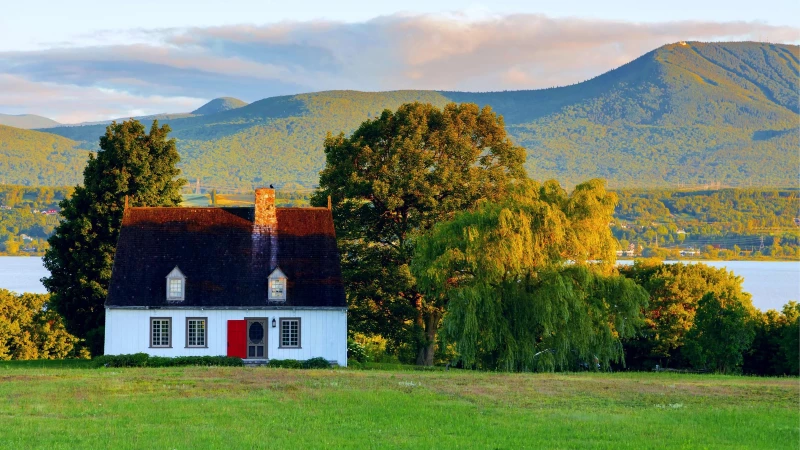
The Île d'Orléans, located in the heart of the Saint Lawrence River near Quebec, is a bucolic getaway offering an immersion into the rural charm of Canada. Rich in history, this island is often nicknamed the "Garden of Quebec" due to its picturesque agricultural landscapes and thriving orchards.
Surrounded by the river, the island provides spectacular views of the mountains, Montmorency Falls, and the city of Quebec in the distance. Visitors can explore quaint villages such as Sainte-Pétronille and Saint-Jean, each with its unique character and artisanal shops.
Île d'Orléans is renowned for its local products, including strawberries, apples, and maple products. Gourmets can indulge in local specialties at the island's numerous stalls, shops, and restaurants.
Activities such as fruit picking, wine tasting in local vineyards, and exploring historical circuits make this island an ideal getaway for nature and history enthusiasts, offering a peaceful respite close to the bustling city life.
 Our tips for getting the most out of your experience.
Our tips for getting the most out of your experience.
Exploring Île d'Orléans is a delightful and discovery-rich experience. Here are some tips to make the most of your visit:
-
Start Early in the Morning: To fully enjoy the day and avoid crowds, consider beginning your visit early in the morning.
-
Explore Picturesque Villages: Take the time to visit villages such as Sainte-Pétronille and Saint-Jean. Each has its unique charm with artisanal shops, art galleries, and cafes.
-
Tour Local Products Stands: Don't miss out on tasting local delights. Explore stands with fresh products, orchards, and shops offering island specialties.
-
Opt for Bicycle Rentals: The island is relatively flat and well-suited for cycling. Renting a bike allows you to explore the island at your own pace and fully appreciate the landscapes.
-
Visit the Vineyards: Île d'Orléans is home to charming vineyards. Enjoy tastings of local wines and discover the unique flavors of the region.
-
Stay Informed About Local Events: Check the event calendar to see if there are festivals, farmers' markets, or other special activities during your visit.
-
Explore Historical Circuits: Learn more about the island's history by following historical circuits. Interpretive panels are often present to guide you.
-
Enjoy the Viewpoints: Viewpoints, such as the one in Sainte-Pétronille, offer panoramic views of the Saint Lawrence River and the city of Quebec.
-
Learn About Local Crafts: The island is known for its craftsmanship. Look for unique souvenirs such as pottery, textiles, and artworks.
-
Book a Table at a Local Restaurant: End your day by savoring a meal in one of the local restaurants that highlight the island's fresh produce.
By following these tips, you can fully discover the beauty and diversity of Île d'Orléans.
Quebec - Where to Stay?
In Quebec City, you'll find a variety of accommodation options catering to different tastes and budgets. Here are some neighborhood suggestions where you might consider staying in Quebec:
-
Old Quebec (Lower Town and Upper Town): This is the historic heart of Quebec City, divided into Lower Town (along the river) and Upper Town (elevated). Charming hotels, inns, and luxury accommodations are available here, all within close proximity to major tourist attractions.
-
Saint-Roch: This up-and-coming neighborhood offers a trendy atmosphere with restaurants, shops, and a lively nightlife. It's also well-connected to Old Quebec by public transportation.
-
Montcalm: Located near Old Quebec, the Montcalm neighborhood is known for its tree-lined streets, parks, and a peaceful residential ambiance. It's an ideal option for those seeking a quieter environment while remaining close to the city center.
-
Limoilou: Situated north of Lower Town, Limoilou is undergoing a revitalization. You'll find residential neighborhoods, parks, and an authentic local atmosphere. Limoilou also offers a variety of accommodations, from bed and breakfasts to apartments.
-
Île d'Orléans: If you're looking for a more rural and picturesque experience, Île d'Orléans, located near Quebec City, provides cottages, inns, and guesthouses amidst bucolic landscapes.
-
Sillery: This peaceful residential neighborhood, a bit farther from the city center, offers elegant accommodations and easy access to parks and green spaces.
When choosing your accommodation, consider your preferences in terms of location, budget, and type of lodging (hotel, hostel, apartment rental, etc.). Most neighborhoods in Quebec City provide easy access to public transportation, facilitating travel around the city.
Quebec - How to get around?
In Quebec City, you have several options for getting around the city and its surroundings. Here are some means of transportation available:
-
On Foot: Downtown Quebec City, especially Old Quebec, is very pedestrian-friendly. You can explore the cobblestone streets, historic squares, and tourist attractions on foot.
-
Biking: Quebec City has bike paths and bike-sharing stations. It's a pleasant way to get around, especially during the warmer months. Some neighborhoods, like the Samuel-De Champlain Promenade, offer specially designed routes for cyclists.
-
Public Transportation: The Réseau de transport de la Capitale (RTC) operates buses that serve Quebec City. They are a convenient and affordable way to travel within the city and its surroundings. Various types of tickets and rechargeable smart cards are available.
-
Car: If you prefer the flexibility of a car, you can rent a vehicle. However, in downtown Quebec City, traffic can be heavy, and parking can be challenging. Additionally, the old town has narrow and winding streets.
-
Taxis and Ride-Sharing Services: Taxis are available throughout the city. Moreover, ride-sharing services like Uber are operational in Quebec City.
-
Funicular: To travel between Lower Town and Upper Town (or vice versa), you can use the funicular, providing a panoramic view of the St. Lawrence River.
-
Ferry Service: In the summer, a ferry service connects Old Quebec to Lévis on the other side of the St. Lawrence River. It's a picturesque option to enjoy views of the city from the water.
-
Train and Intercity Coaches: If you wish to explore more of the province of Quebec, train and intercity coach services can take you to destinations such as Montreal and other nearby cities.
Most of Quebec City's tourist attractions are concentrated in the downtown area, making it easy to get around on foot or by public transportation. Plan your travels based on your preferences and the neighborhood you want to explore.
Quebec - Best period
The best time to visit Québec depends on your preferences regarding climate and activities. Here's a breakdown of the different seasons to help you make an informed decision:
-
Summer (June to August): Summer is a highly popular time to visit Québec. The temperatures are generally pleasant, ranging from mild to warm. It's the ideal season for exploring Old Québec City, participating in festivals, enjoying outdoor cafes, and taking excursions in the surrounding areas.
-
Fall (September to November): Fall in Québec is beautiful with changing leaves, creating a spectacular landscape. Temperatures can be cool, but the weather is generally pleasant. This is a recommended time for photography enthusiasts and those who appreciate a quieter atmosphere.
-
Winter (December to February): If you enjoy winter and activities associated with the season, Québec's Winter Carnival (in January or February) is an iconic experience. Temperatures are cold, but the city comes alive with winter festivities.
-
Spring (March to May): Spring can be a transitional period with temperatures gradually increasing. It's a season of renewal, and some attractions may be less crowded than in the summer.
In summary, summer is the most popular season to visit Québec due to pleasant temperatures and numerous outdoor activities. However, if you prefer cooler conditions and an autumnal atmosphere, or if you're a fan of winter activities, fall or winter could also be attractive choices.
